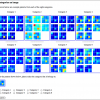Free Online Productivity Tools
i2Speak
i2Symbol
i2OCR
iTex2Img
iWeb2Print
iWeb2Shot
i2Type
iPdf2Split
iPdf2Merge
i2Bopomofo
i2Arabic
i2Style
i2Image
i2PDF
iLatex2Rtf
Sci2ools
CVPR
2010
IEEE
2010
IEEE
The Role of Features, Algorithms and Data in Visual Recognition
There are many computer vision algorithms developed for visual (scene and object) recognition. Some systems focus on involved learning algorithms, some leverage millions of training images, and some systems focus on modeling relevant information (features) with the goal of effective recognition. However, none of these systems come close to human capabilities. If we study human responses on similar problems we could gain insight into which of the three factors (1) learning algorithm (2) amount of training data and (3) features is critical to humans’ superior performance.
In this work we take a small step towards this goal by performing a series of human studies and machine experiments. We find no evidence that human pattern matching algorithms are better than standard machine learning algorithms. Moreover, we find that humans don’t leverage increased amounts of training data. Through statistical analysis on the machine experiments and supporting human studies, we find that the m...
Computer Vision | CVPR 2010 | Datasets | Features | Human Studies | Learning Algorithms | Reverse Engineering Humans | Visual Recognition |
Related Content
| Added | 29 Mar 2010 |
| Updated | 14 May 2010 |
| Type | Conference |
| Year | 2010 |
| Where | CVPR |
| Authors | Devi Parikh and C. Lawrence Zitnick |
Comments (0)






